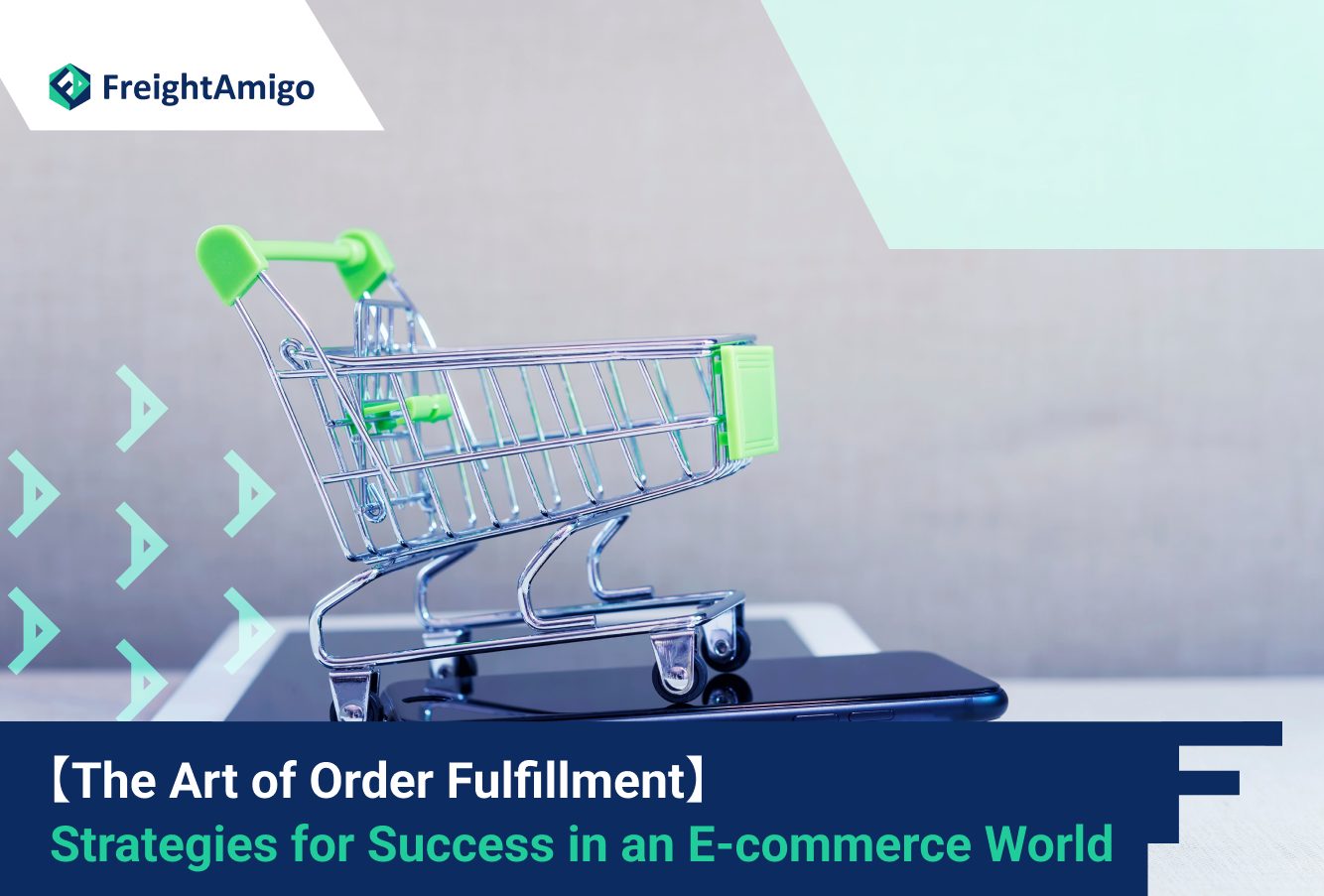Author Name: Tiffany Lee – Marketing Analyst at FreightAmigo
What is order fulfillment?
Order fulfillment is the process of receiving, processing, and delivering customer orders. In the world of e-commerce, this process has become increasingly important as more and more consumers turn to online shopping. It involves various steps, starting from the moment a customer places an order to the moment the product is delivered to their doorstep. Efficient order fulfillment ensures customer satisfaction, repeat business, and positive brand reputation.
Want To Compare The Best Express, Air Freight, Sea Freight, Rail Freight & Trucking Rates So As To Have Better Control On Cost?
Importance of efficient order fulfillment
Efficient order fulfillment is crucial for the success of any e-commerce business. Customers have come to expect fast and accurate delivery of their purchases, and failure to meet these expectations can result in lost sales and negative reviews. On the other hand, businesses that prioritize order fulfillment can gain a competitive advantage by providing exceptional customer service. This leads to increased customer loyalty, positive word-of-mouth, and higher conversion rates.
According to a study by Deloitte, 55% of consumers are willing to pay more for a better customer experience. This includes fast and reliable order fulfillment. By investing in efficient order fulfillment processes, businesses can not only meet customer expectations but also exceed them, resulting in increased customer satisfaction and loyalty.
Key components of the order fulfillment process
The order fulfillment process consists of several key components that work together to ensure seamless delivery of products to customers. These components include:
1. Order processing: This involves receiving and verifying customer orders, including checking inventory availability and payment processing. It is essential to have an efficient order processing system in place to avoid errors and delays.
2. Inventory management: Proper inventory management is crucial to ensure that products are available for fulfillment. Real-time inventory tracking and forecasting techniques can help businesses optimize their inventory levels and avoid stockouts or overstock situations.
3. Pick and pack: Once an order is received, the products need to be picked from the warehouse shelves and packed securely for shipment. This process requires careful attention to detail to ensure accurate order fulfillment and minimize the risk of damaged products during transit.
4. Shipping and delivery: Choosing the right shipping carrier and method is crucial for timely and cost-effective delivery. Tracking information should also be provided to customers to keep them informed about the status of their orders.
By focusing on these key components, businesses can streamline their order fulfillment process and provide a positive customer experience.
Choosing the right order fulfillment services
For businesses looking to outsource their order fulfillment process, choosing the right order fulfillment services is vital. Here are some factors to consider:
1. Location: The proximity of the fulfillment center to your customers can significantly impact shipping times and costs. Look for fulfillment centers strategically located near your target market to ensure fast and affordable delivery.
2. Scalability: As your business grows, you need a fulfillment partner that can scale with you. Ensure that the fulfillment service provider has the capacity to handle increasing order volumes without sacrificing quality and efficiency.
3. Technology integration: Seamless integration between your e-commerce platform and the fulfillment service provider’s system is essential. This allows for real-time order and inventory updates, reducing the risk of errors and delays.
4. Service level agreements (SLAs): Clear SLAs ensure that the fulfillment service provider meets your specific requirements, such as order accuracy, processing times, and customer service. Review and negotiate these SLAs to align with your business goals.
By carefully evaluating these factors and partnering with the right order fulfillment service provider, you can offload the complexities of order fulfillment while maintaining high customer satisfaction.
Optimizing your order fulfillment logistics
To achieve efficient order fulfillment, optimizing your logistics is crucial. Here are some strategies to consider:
1. Warehouse layout and organization: An efficient warehouse layout can minimize the time and effort required to pick and pack orders. Organize products strategically, based on their popularity and frequency of orders, to minimize travel time and improve efficiency.
2. Automation and technology: Invest in automation and technology solutions to streamline your order fulfillment process. This can include barcode scanning, automated picking systems, and inventory management software. These technologies can improve accuracy, reduce errors, and increase overall efficiency.
3. Outsourcing non-core tasks: Consider outsourcing non-core tasks, such as packaging and shipping, to specialized providers. This allows you to focus on your core competencies while benefiting from the expertise and efficiency of external partners.
4. Continuous improvement: Regularly review and analyze your order fulfillment processes to identify areas for improvement. Solicit feedback from customers and employees to gain insights and implement changes that enhance efficiency and customer satisfaction.
By implementing these optimization strategies, you can enhance your order fulfillment logistics and deliver exceptional customer experiences.
Common challenges in order fulfillment and how to overcome them
Despite the best efforts, order fulfillment can present various challenges. Let’s explore some common challenges and effective solutions:
1. Inventory management: Inaccurate inventory counts can lead to stockouts or overstock situations. Implement real-time inventory tracking systems and regularly conduct physical audits to ensure accurate inventory levels.
2. Returns and exchanges: Dealing with returns and exchanges can be complex and time-consuming. Develop clear return policies and streamline the process by providing customers with pre-paid return labels and a user-friendly returns portal.
3. Seasonal fluctuations: During peak seasons, order volumes can skyrocket, putting strain on fulfillment operations. Plan ahead by hiring temporary staff, optimizing warehouse space, and collaborating closely with your fulfillment service provider to ensure smooth operations.
4. Customer communication: Keeping customers informed about their order status is crucial for a positive experience. Implement automated emails or SMS notifications at key milestones, such as order confirmation, shipping updates, and delivery notifications.
By proactively addressing these challenges and implementing effective solutions, businesses can overcome obstacles and ensure efficient order fulfillment.
Conclusion
Efficient order fulfillment is the backbone of successful e-commerce businesses. By understanding the key components of the order fulfillment process, choosing the right order fulfillment services, optimizing logistics, and overcoming common challenges, businesses can provide exceptional customer experiences and gain a competitive edge in the e-commerce world.
Remember, the art of order fulfillment requires continuous improvement and adaptation to evolving customer expectations. By prioritizing efficiency and customer satisfaction, businesses can thrive in the rapidly changing landscape of e-commerce.
There Are Different Options For Cargo Transportation. If You Want To Choose The Most Convenient And Suitable Solution, It Is Best To Have The Full Support Of Logistics Experts! If You Are Planning To Ship Goods Overseas, Please Go To The FreightAmigo Page For Inquiries.
===
Read More:
【Cosmetic Product Recycling】 A Guide to Sustainable Reverse Logistics
【Rise of Green Supply Chain】 Pioneering Sustainable Practices in Logistics
【ESG in Logistics】 How ESG Practices Drive Social Responsibility in Logistics
===
If you have any inquiries on logistics/supply chain, feel free to contact FreightAmigo now:
Chat with us online OR
Phone : +852 28121686
WhatsApp: +852 27467829









































